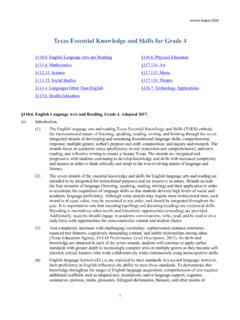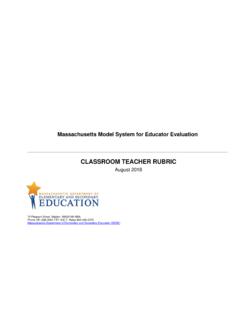Transcription of Five Oral Reading Fluency Strategies for Supporting ...
1 National Youth-At-Risk JournalVolume 3 Issue 1 Fall 2018 Article 3 Five Oral Reading Fluency Strategies forSupporting Struggling Adolescent ReadersKavin M. MingWinthrop UniversityFollow this and additional works at: literature synthesis is brought to you for free and open access by the Journals at Digital Commons@Georgia Southern. It has been accepted forinclusion in National Youth-At-Risk Journal by an authorized administrator of Digital Commons@Georgia Southern. For more information, CitationMing, K. M. (2018). Five Oral Reading Fluency Strategies for Supporting Struggling Adolescent Youth-At-RiskJournal, 3(1). Oral Reading Fluency Strategies for Supporting StrugglingAdolescent ReadersAbstractBy the time students enter the fourth grade, it is expected that they possess the basic literacy skills needed toread and learn content.
2 It is the general belief that in the early grades, students are taught foundational literacyskills that make them proficient readers by the time they become adolescent learners. For many, thisassumption is true. However, for a large majority of students between Grades 4 and 12, basic literacy skills arenot in place, leading them to struggle to acquire information. Oral Reading Fluency , one of the basic literacyskills that adolescents must possess, can be explicitly taught beyond the early years. In this article, the authordiscusses who are struggling adolescent readers, what is oral Reading Fluency and why it is significant for thisgroup, and how five specific Strategies can be used with this Reading Fluency , struggling readers, adolescent learners, strategy instructionThis literature synthesis is available in National Youth-At-Risk Journal: Oral Reading Fluency Strategies for Supporting Struggling Adolescent ReadersKavin M.
3 MingWinthrop UniversityWhen students enter the fourth grade, they are considered to be adolescent learners (Biancarosa & Snow, 2004). This occurs because fourth grade signifies the point at which students transition from learning to read to using Reading to acquire content knowledge (Chall, 1983). Large numbers of students in Grades 4 12 are lacking foundational Reading skills, which causes them to be two or more years below grade level. These students are categorized as adolescent struggling readers (Torgesen, 2005). According to the 2015 report by the National Center for Education Statistics, 31% of fourth-grade students and 24% of eighth-grade students scored below the basic level in overall Reading skills, and 33% of fourth-grade students and 42% of fourth-grade students scored at the basic level.
4 Collectively, almost two-thirds of fourth- and eighth-grade students are at or below grade level in their overall Reading performance. Students at this age struggle for a variety of reasons, and one cause is a lack of adequately developed word level Reading proficiency. In this case, students are unable to fluently decode words to allow them to read with ease (Hock et al., 2009). One of the reasons why this occurs is because some students have not fully internalized the alphabetic code. That is, they have deficits in their ability to automatically interact with the written symbols on the page to meaningfully read connected text (Moats, 2001). This deficit occurs because of a lack of explicit instruction in word identification techniques and/or the innate challenges that some students possess (Rupley, Blair, & Nichols, 2009; Shaywitz & Shaywitz, 2008).
5 Reading thus becomes a laborious, dreaded, and unsatisfying experience, with many of these students giving up and dropping out of school simply because what is being asked of them is more than they can do (Hernandez, 2011). ORAL Reading FLUENCYThe National Institute of Child Health and Human Development (2000), in its Report of the National Reading Panel, identified Reading Fluency as one of the five critical components necessary for proficient Reading . Oral Reading Fluency refers to the ability to read quickly and accurately, with smoothness, phrasing, and expression (Miller & Schwanenflugel, 2008; Rasinski, 2003). It is of particular significance to adolescent struggling readers because the emphasis on developing fluent Reading often occurs during the earlier years when students are learning to read.
6 The assumption is often made that by the time students enter the fourth grade, this foundational skill is in place and teaching fluent Reading is no longer a priority (Joseph & Schisler, 2009). However, this assumption does not hold true for many adolescent struggling readers who have not mastered foundational Reading skills (Sedita, 2011). For students to improve their Fluency skills, they must continue to receive explicit instruction in oral Reading Fluency (Rasinski et al., 2005). Dudley and Mather (2005) provided the AIMSweb measures that indicate where students should be Reading at specific grade levels. By the end of elementary school (fifth grade), students performing at the 50th percentile should be Reading approximately 140 words correct per minute (wcpm), and this number increases to 156 wcpm by the end of 13 Ming: Five Oral Reading Fluency Strategies for Adolescent ReadersPublished by Digital Commons@Georgia Southern, 2018the eighth grade.
7 These numbers support the idea that in order for students to continue to progress in their Reading development, they must be explicitly taught and must receive opportunities to practice their Reading . This is especially crucial for adolescent struggling readers. Accurate and fast Reading of connected text has been shown to increase Reading comprehension. This kind of Reading supports working memory as it processes large chunks of text (Chard, Pikulski, & McDonagh, 2006). As adolescent learners move through the grades, the academic demands that they are expected to meet increase. During these years, older students are required to read new and dense material, make connections across concepts, interpret ideas, and solve abstract problems (Wehby & Falk, 2016).
8 To be successful, they must actively keep track of super and subordinate ideas, follow the authors line of thinking, monitor their own understanding, and realize when a breakdown in comprehension occurs (Garnett, 2011). All of these literacy skills require students to focus on the task of processing the information with which they are interacting. If they struggle to read text quickly and accurately, they will not be able to attend to the content as their focus will be on identifying the words on the page. According to LaBerge and Samuels (1974), students need automatic word recognition if their attention and processing skills are to be devoted to the comprehension of text. According to Joseph and Schisler (2009), little direction is provided to teachers of adolescent learners about how to use effective instructional tools to develop the basic Reading skills of struggling adolescent readers.
9 However, there are several research-based recommendations for how to provide Reading instruction to build oral Reading Fluency to support this group s Reading development. These Strategies can assist struggling adolescent readers in achieving proficiency in the areas of Reading rate, word recognition, and prosody, which ultimately helps to improve Reading Fluency STRATEGIESRead Non-controlled Decodable TextsWhat is this strategy? Non-controlled decodable texts are texts that students can read with at least 95% accuracy (Wilson, 2011). These books make use of highly decodable basic phonetic patterns and sounds that make them manageable for older struggling readers. While non-controlled means that students have not explicitly learned all of the patterns that are presented in the text, because of its high emphasis on the use of decodable words, students are able to apply both context clues and sounding out procedures to determine unfamiliar words.
10 High interest-low level readers are one kind of non-controlled decodable text that is appropriate for this population. As the name indicates, these books are highly relevant to adolescent readers as their content and appearance are age appropriate. However, they are written at lower Reading levels that provide support to struggling readers. High interest-low level readers can be found at the following websites:High Noon Books High Interest Publishing (HIP) Books Orca Book Publishers Remedia Publications Start-to-Finish LibraryWieser Educational Why does it support adolescent struggling readers? Non-controlled decodable texts benefit adolescent struggling readers because they provide students with the opportunity to meaningfully engage with text at their Reading levels.


















